Feel like your body just doesn’t want to move?
You reach down to tie your shoe or twist to grab something behind you, and suddenly your body acts like it’s made of stone. Tight hips, stiff hamstrings, shoulders that barely move — this stuff adds up.
It messes with how you walk, sit, sleep, and even how you breathe.
And no, it’s not just because you’re “getting older.” It’s because your muscles stay stuck in the same positions for too long. When you don’t move much, your body starts to lose that ability.
This guide keeps things simple. You’ll learn what flexibility really means, how to stretch without overdoing it, and which beginner-friendly moves actually make a difference. Plus, there’s a weekly plan that fits into your everyday routine — even if your schedule is nonstop.
Scroll down or save this for later. Because standing up from the couch shouldn’t sound like popcorn in the microwave.
Why Flexibility Matters (Even If You’re Not Doing Splits)
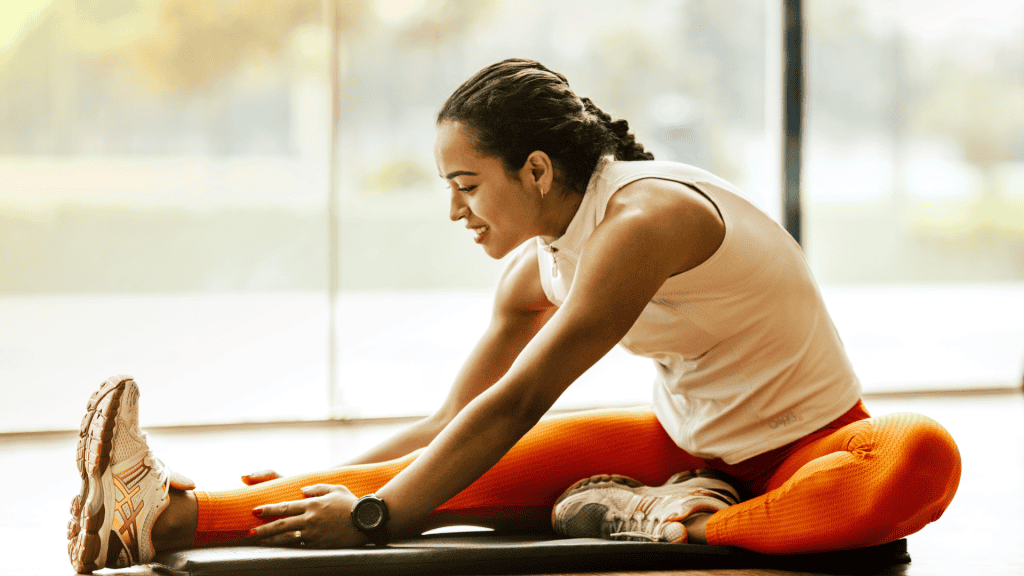
Flexibility isn’t about doing the splits or folding yourself into a pretzel. It’s about making everyday movement feel easier and more comfortable.
When your muscles are more flexible, things like tying your shoes, reaching overhead, or getting up from a chair don’t feel like a workout. You move better because your body isn’t constantly fighting tightness in your hips, back, or shoulders.
Besides, stretching helps your posture by keeping your muscles and joints in better balance. That means less strain on spots that usually carry stress, like your neck, lower back, and knees. And when your body moves the way it’s supposed to, you’re less likely to pull something just by twisting the wrong way.
You’ll probably also notice less soreness after workouts or long days of sitting. When your muscles aren’t locked up, your body doesn’t have to work as hard to do basic things.
Improving flexibility doesn’t happen overnight, but it doesn’t have to be complicated either. A few minutes here and there can really add up. So let’s walk through the stretches that actually help.
10 Beginner Stretches for Flexibility You Can Start Today
You don’t need to be super bendy, athletic, or fully “into fitness” to become more flexible. You just need to do a few stretches for your back, neck, and other parts of your body. (and a little consistency) These 10 moves are made for regular people with regular stiffness. (no splits, no pressure)
Each one focuses on an area that often feels tight. And every cue is written so it actually makes sense
1. Neck Release Stretch
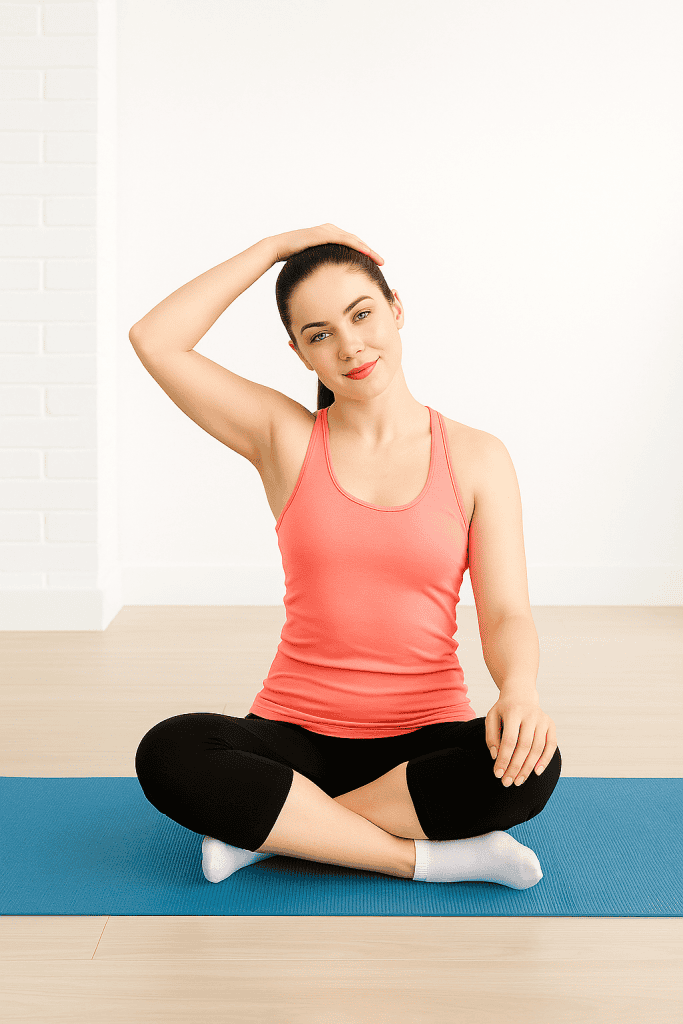
If your neck feels stiff after sleeping weird or hunching over a screen, this one’s for you.
Sit or stand up tall. Slowly tilt your right ear toward your right shoulder until you feel a gentle stretch down the left side of your neck. Let your left arm hang by your side and keep both shoulders relaxed.
Hold for 30 seconds, then switch sides.
What it helps: Releases neck and upper shoulder tension (aka the “I’ve been stressed all day” spot).
Tip: Don’t force your head down just let gravity do the work.
2. Shoulder Roll + Reach
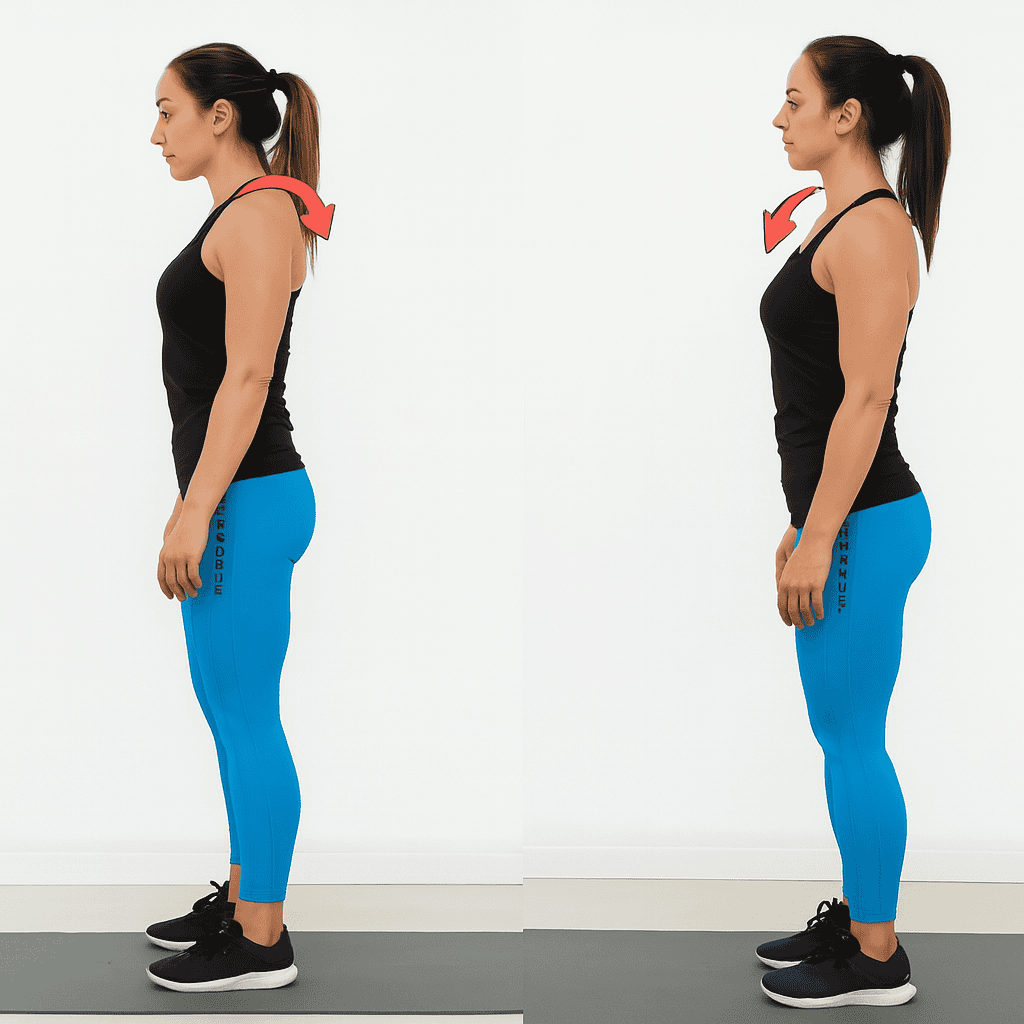
Start by rolling your shoulders in big, slow circles—three to five times forward, then backward. Next, lift both arms straight up overhead like you’re stretching after a nap.
Reach tall and hold for a few breaths.
What it helps: Loosens stiff shoulders, opens your chest, and gives slouchy posture a reset.
Tip: Keep your arms near your ears and avoid arching your lower back.
3. Standing Forward Fold
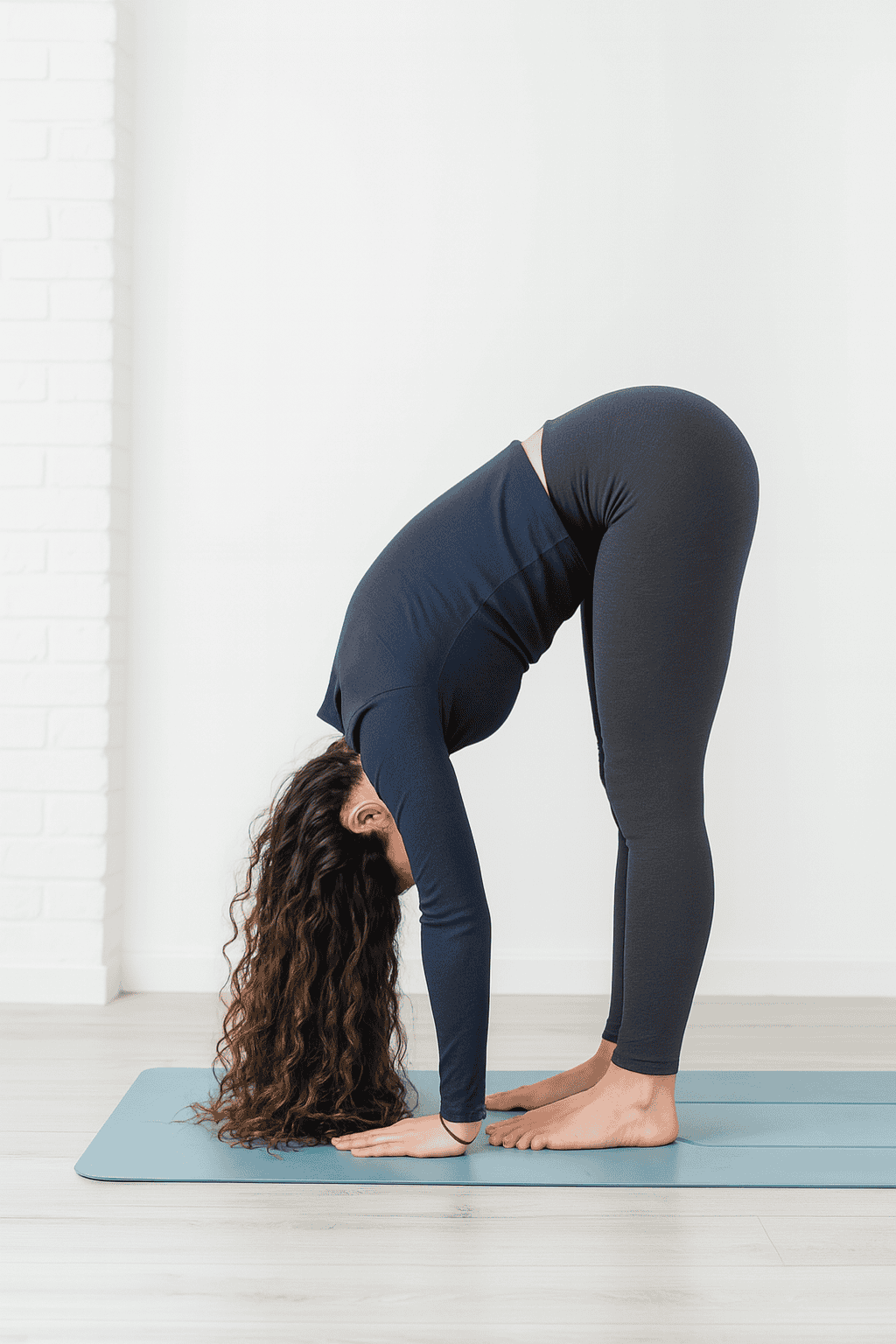
Stand with your feet hip-width apart, then slowly fold forward from the hips. Let your arms hang toward the ground and relax your neck completely. You can bend your knees slightly especially if your hamstrings are tight.
What it helps: Stretches your lower back, hips, and the backs of your legs.
Tip: Don’t try to touch your toes right away. Focus on relaxing, not reaching.
4. Hip Flexor Stretch
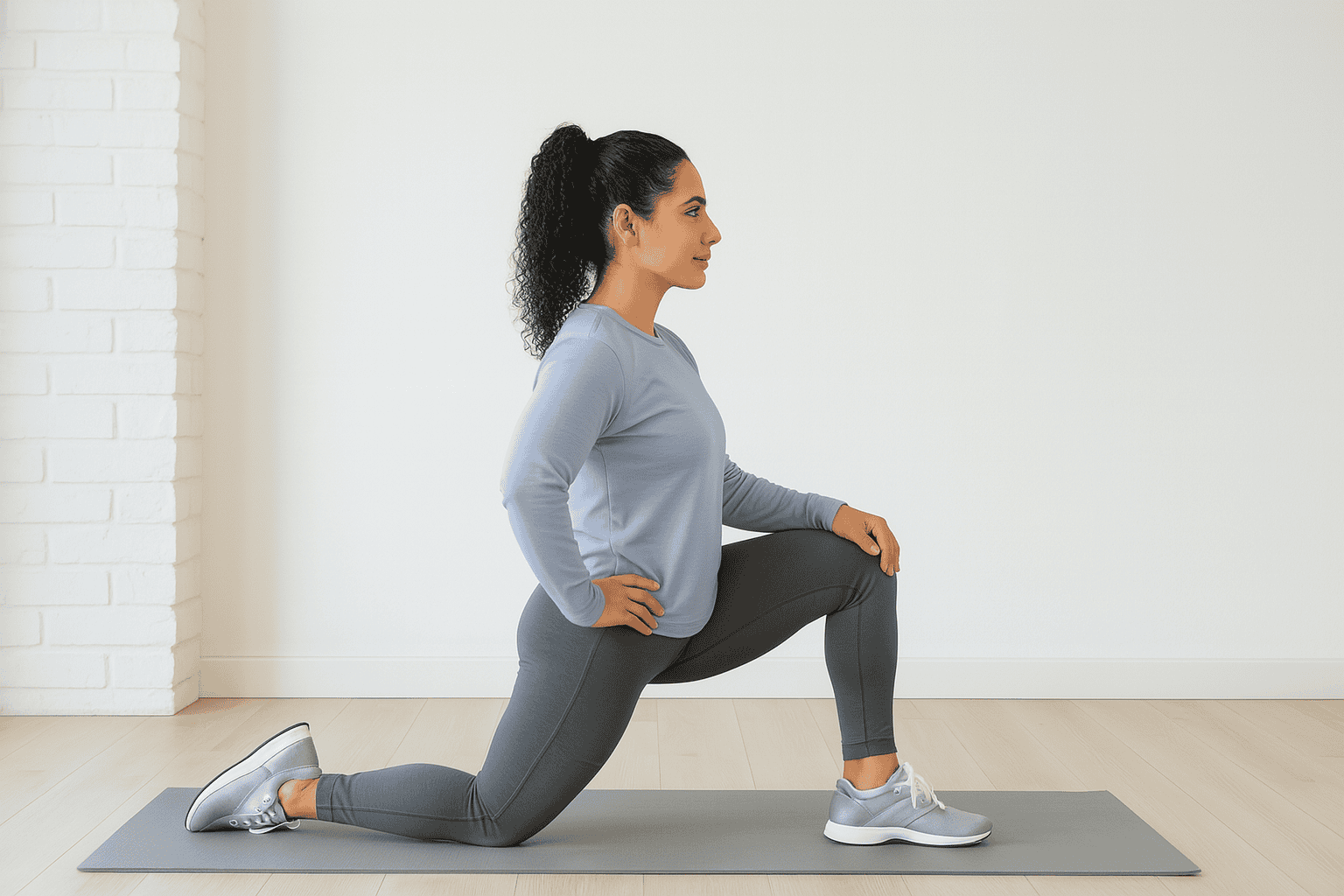
Get into a kneeling position with your right foot forward and your left knee down. Then, gently shift your hips forward until you feel a stretch in the front of your left hip. Keep your chest lifted and your back straight.
What it helps: Loosens up tight hip flexors, especially helpful if you sit a lot during the day.
Tip: Keep your front knee stacked over your ankle. Squeeze your glutes slightly to keep your hips steady.
5. Seated Hamstring Reach
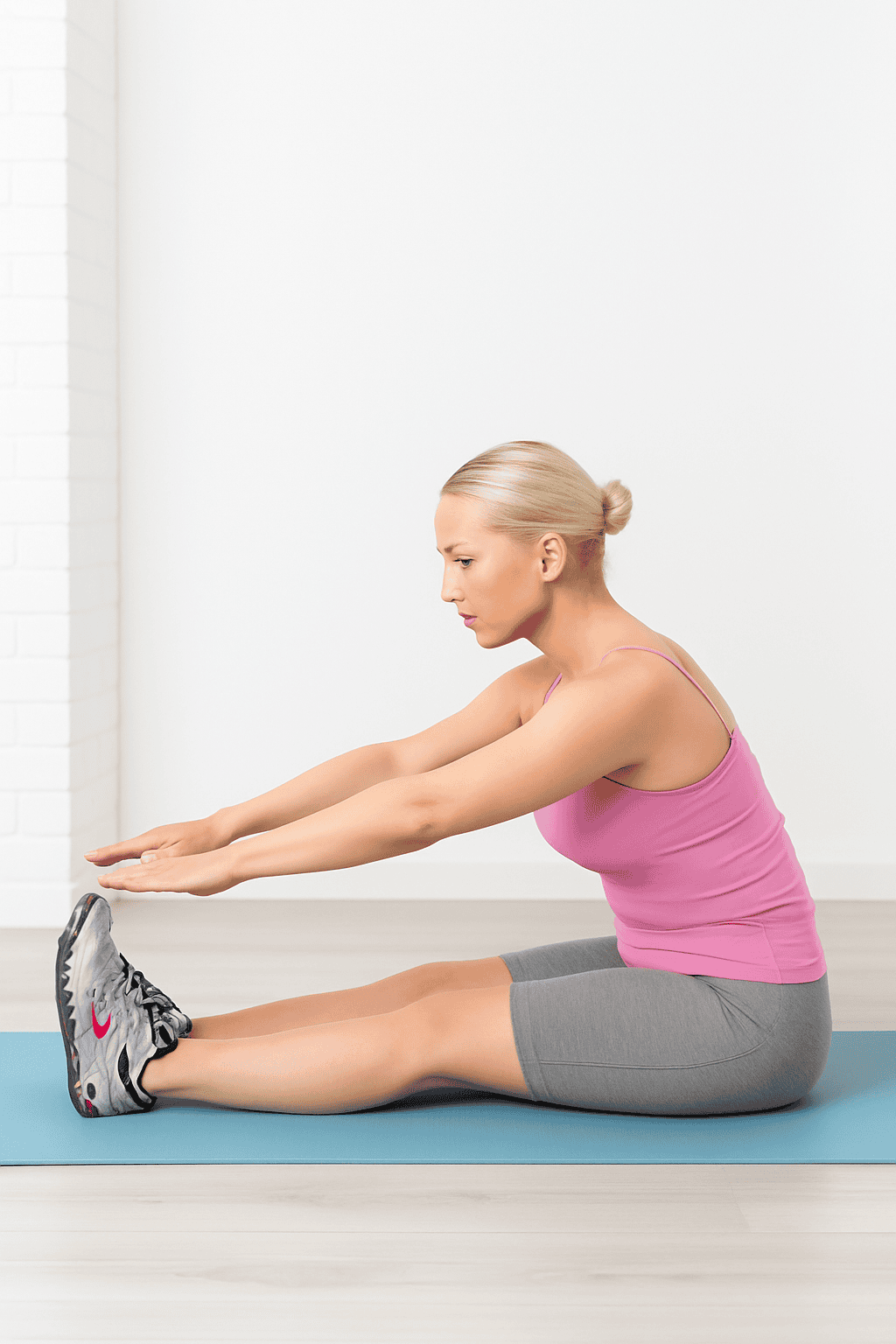
Sit on the floor with both legs stretched straight in front of you. Inhale and sit up tall, then exhale as you reach your hands forward, keeping your back flat. Stop wherever your hands land, even if that’s just your knees.
What it helps: Helps release tight hamstrings and gives your lower back more freedom to move.
Tip: Lead with your chest, not your head. Avoid bouncing or yanking yourself forward
6. Kneeling Quad Stretch
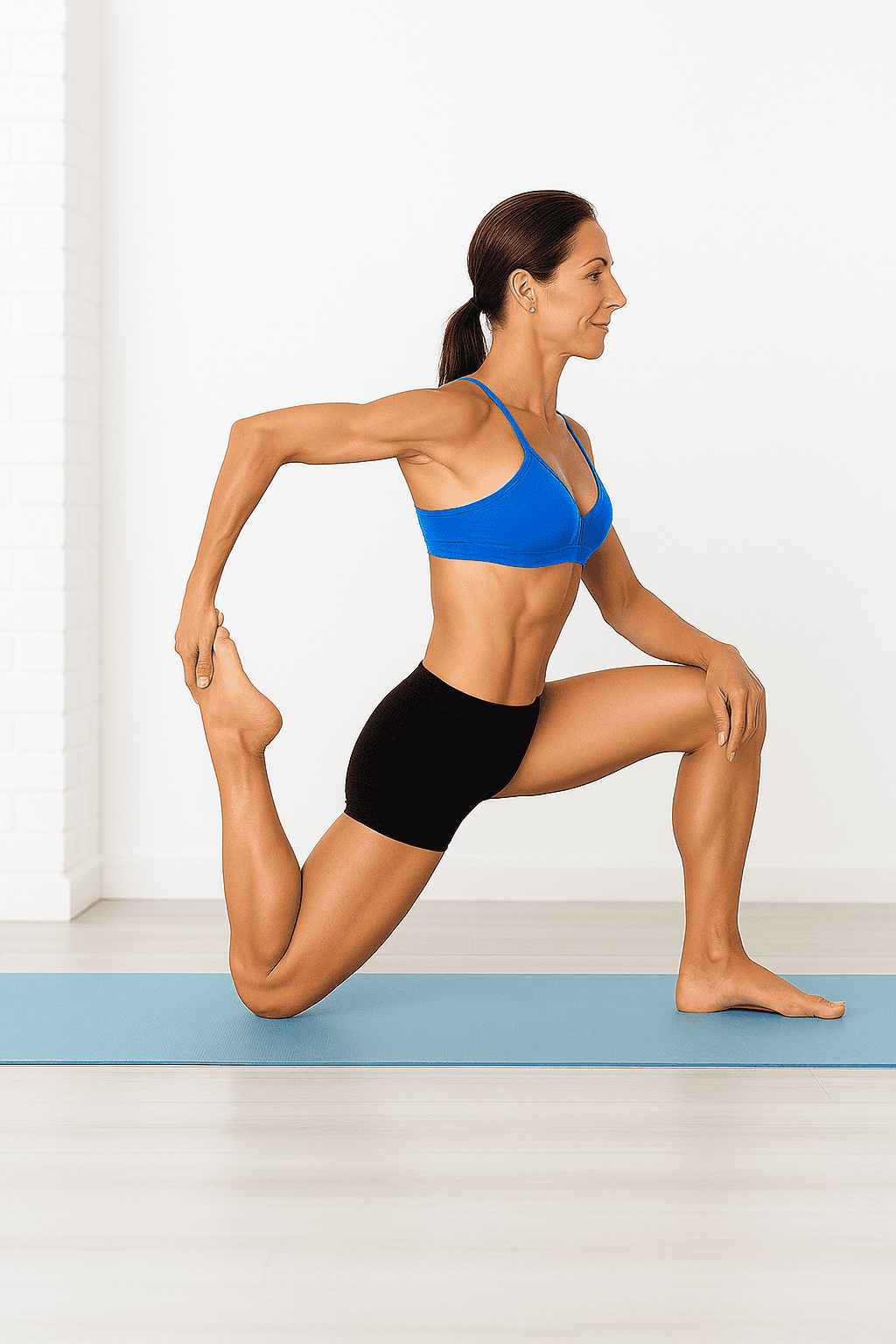
To start, get into a kneeling position. Reach back and grab the ankle of your back leg with the same-side hand. Gently pull your foot toward your glutes. Hold onto a wall or chair if you need help balancing.
What it helps: Stretches the front of your thigh and helps ease pressure in your knees.
Tip: Keep your hips tucked and spine neutral, don’t lean forward or twist.
7. Cross-Body Arm Stretch
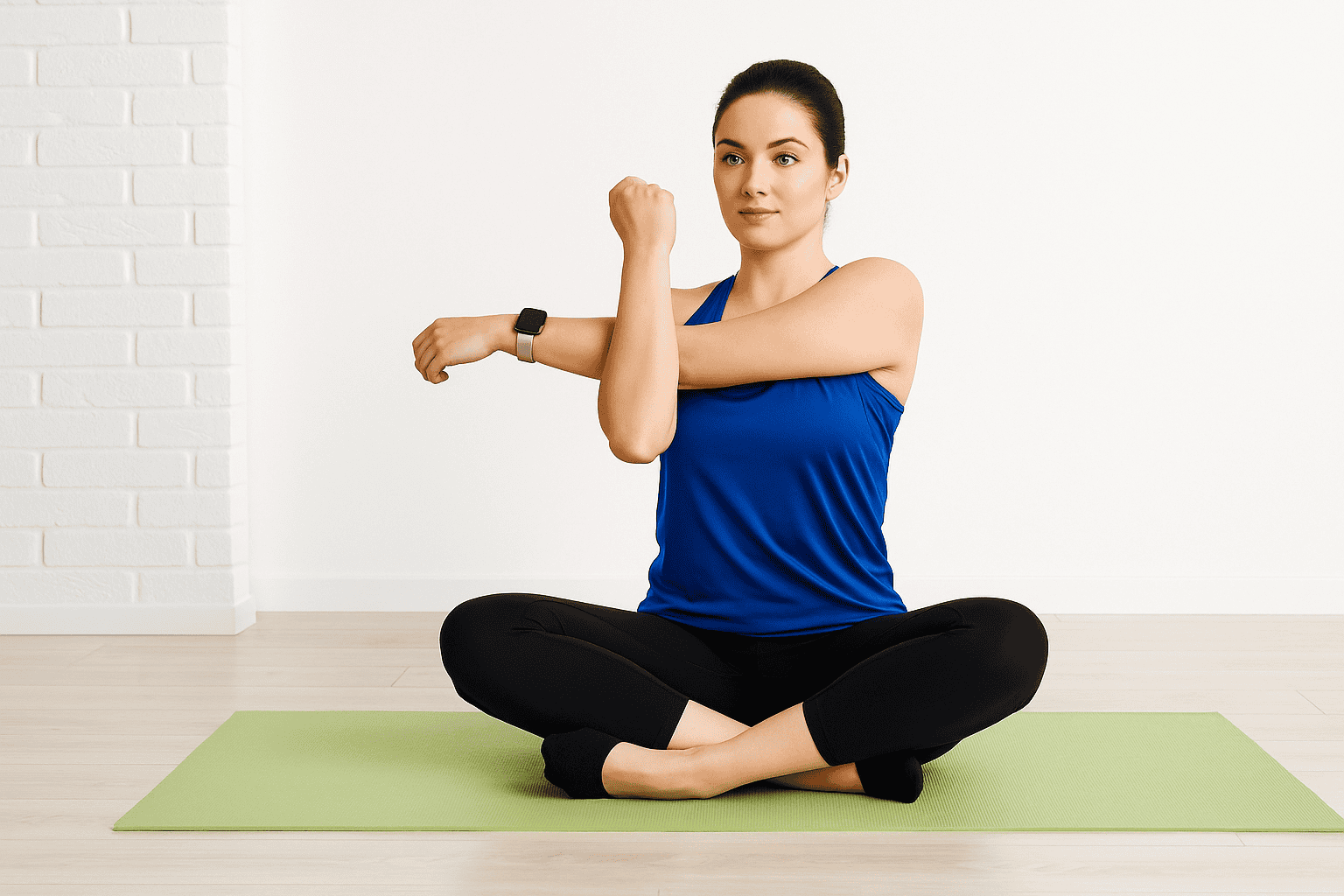
Start by bringing your right arm across your chest. Use your left hand to gently pull your arm closer to your body until you feel a light stretch in your shoulder and upper arm.
Hold for 20 to 30 seconds, then switch arms.
What it helps: Loosens up tight shoulders and upper back (especially if you’ve been scrolling a lot).
Tip: Keep both shoulders relaxed. Don’t twist or lift your chest.
8. Butterfly Stretch
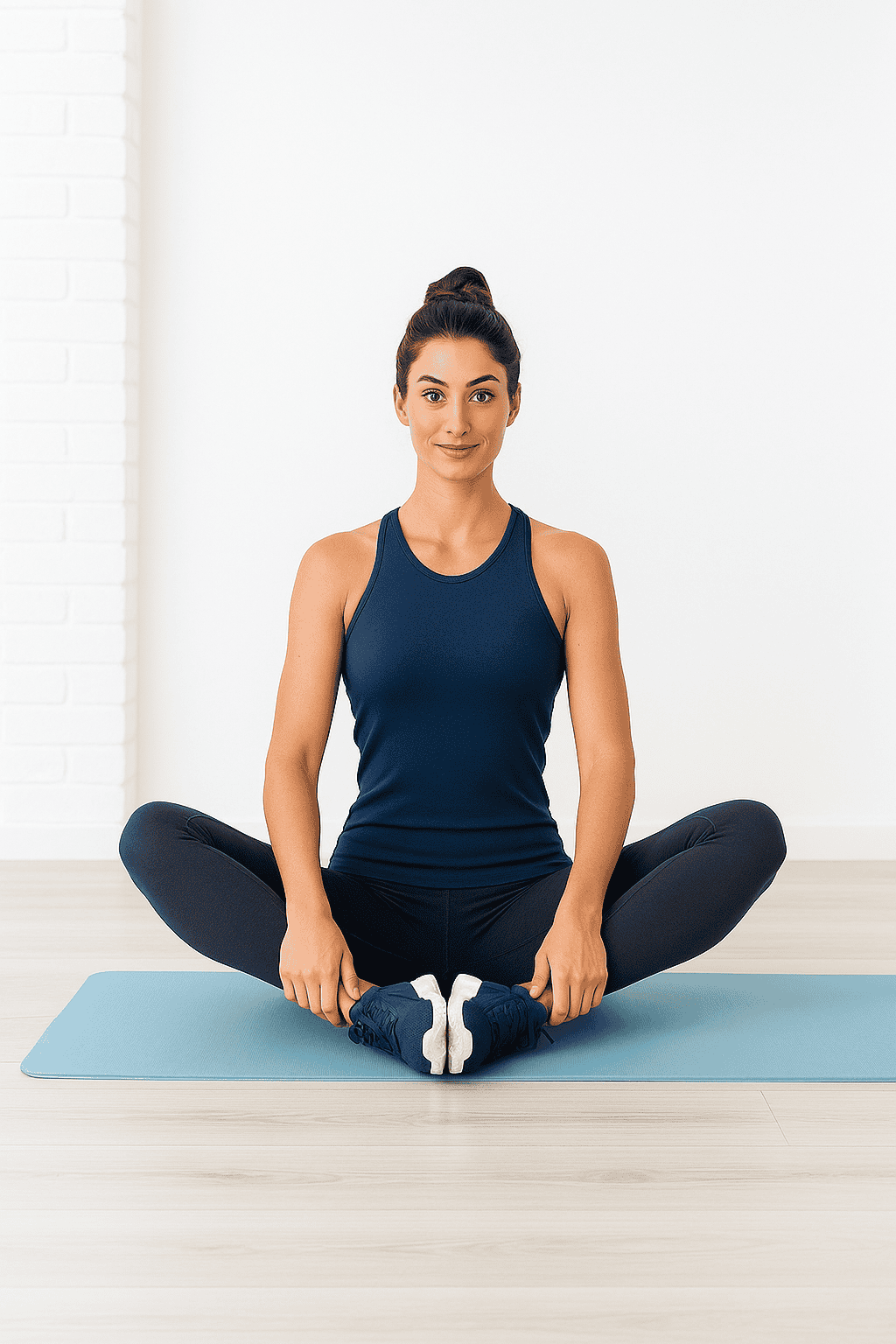
Now let’s focus on your hips and inner thighs. Sit down with the soles of your feet pressed together and let your knees drop out to the sides. Hold your feet or ankles and sit up tall.
It’s totally fine if your knees don’t touch the floor (they’ll get there with time).
What it helps: Opens the inner thighs and hips.
Tip: Keep your spine long, don’t round forward just to get lower.
9. Figure 4 Stretch

Next, let’s give your hips and glutes some extra attention. Lie on your back and cross your right ankle over your left knee, forming a “4” shape. Reach your hands behind your left thigh and gently pull it toward your chest. Keep your head and shoulders resting on the floor.
Hold for about 30 seconds, then switch sides.
What it helps: Targets the glutes and outer hips. (especially helpful if you sit for hours)
Tip: If it’s too intense, rest your foot on a wall instead of pulling with your hands.
10. Side Body Stretch

This stretch is great for waking up your ribs and waist. You can do it standing or sitting still and even cross-legged.
To start, raise one arm overhead and gently lean to the opposite side. If you’re sitting, keep both hips rooted to the floor. You should feel the stretch along the side of your body. Then switch sides and repeat.
What it helps: Loosens tight muscles along the sides of your spine, ribs, and waist.
Tip: Keep your chest open. Don’t slouch or collapse forward while you lean.
A 5-Minute Flexibility Routine You’ll Actually Stick To
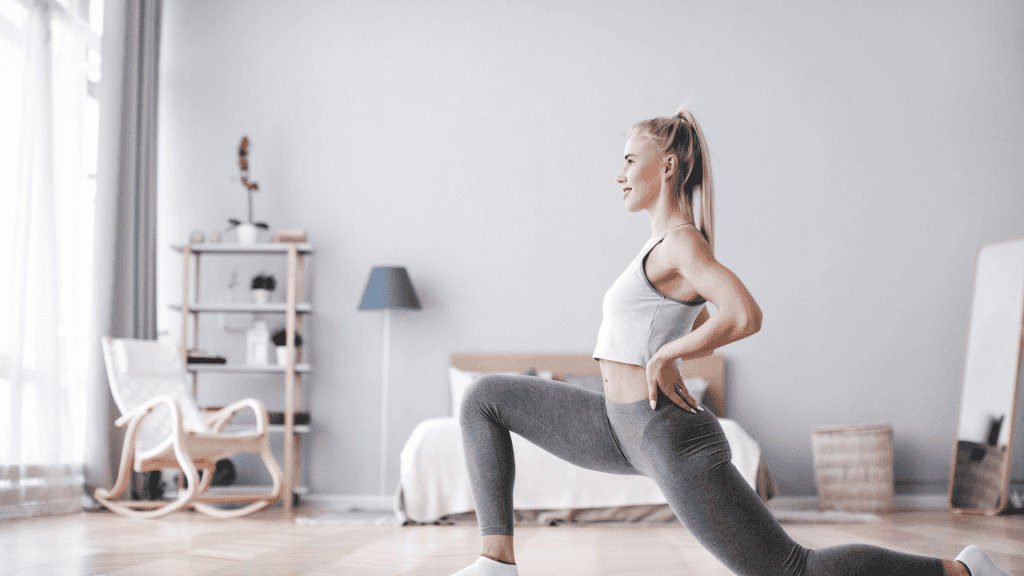
If you’re not sure how to start stretching, this simple routine makes it easy. It’s gentle, beginner-friendly, and takes just five minutes. You don’t need a mat, a timer, or a special setup. Just a bit of space and your body are enough.
To begin, spend about 30 seconds on each stretch. Then, move from one to the next without rushing, and keep your breath slow and steady. This isn’t about doing the deepest stretch or holding the longest. Instead, it’s about showing up and moving with purpose.
Besides being quick, you can use this flow on its own, or before a workout to get your body moving. It helps loosen tight spots in your hips, legs, shoulders, and spine without overcomplicating anything.
If you want to make it feel even better, try putting on calming music or dimming the lights if it’s evening. After you stretch, take one minute to breathe deeply. That small step can help your body relax even more.
In the end, five minutes might not sound like much, but it adds up. Skip the pressure to be perfect—just keep moving.
When to Stretch So It Actually Works
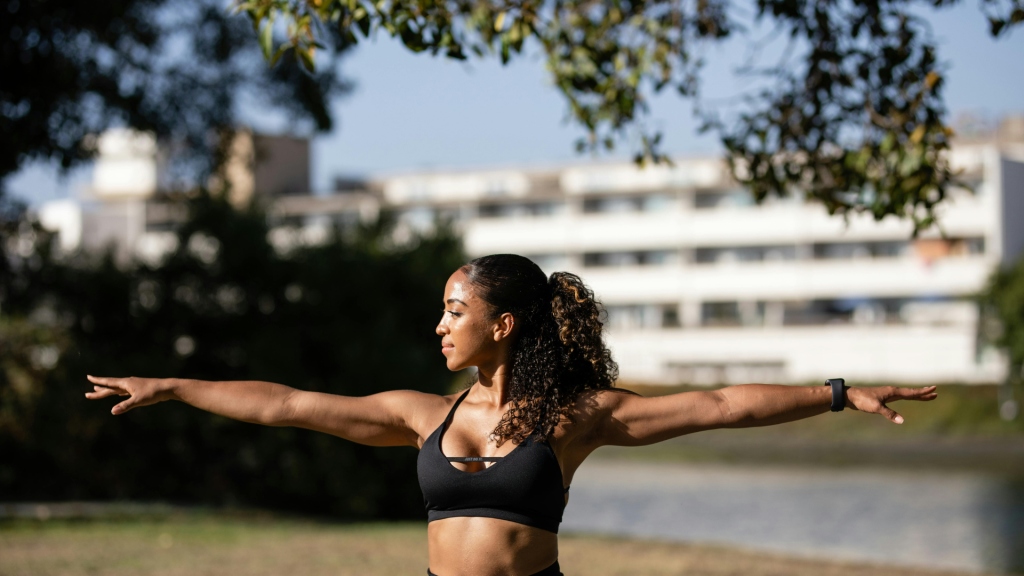
Knowing when to stretch makes a big difference.
To get the most out of your flexibility routine, it’s important to stretch when your body is ready, not when it’s stiff and cold.
Start with this: stretch after your body is slightly warm. That can mean after a short walk, a few minutes of light movement, or even stepping out of a warm shower. When your muscles are warm, they’re more responsive and less likely to feel tight or resistant.
Also, evenings tend to be a great time for stretching. If you’ve been sitting all day, working, or feeling stressed, a gentle routine at night can help release tension.
It can even help you sleep better by relaxing your body and calming your mind.
During the start of your day, you can still stretch in the morning—just keep it light.
Don’t jump straight into deep stretches the second you wake up. Instead, start with small movements like simple shoulder rolls or reaching overhead to ease into it.
One last thing…
Never stretch completely cold. Even just walking in place for a minute can help your body feel more ready and make your stretches more effective.
Tips for Staying Consistent With Flexibility Training
Getting more flexible doesn’t mean you need to push harder or force your body into deep stretches. It’s about working with your body, staying consistent, and keeping things safe and simple.
These tips will help you get more out of every stretch, without doing too much.
1. Breathe slowly and consistently

Your breath tells your body it’s okay to relax. If you’re holding your breath, your muscles stay tense. So as you stretch, inhale through your nose and exhale slowly through your mouth.
Each exhale can help you sink a little deeper, but gently, not by pushing.
2. Use support if you need it
If a stretch feels out of reach or just uncomfortable, try adding support. Use a towel, pillow, or yoga block to give your body extra help.
For example, if your knees hover during a butterfly stretch, slide a towel under each one. This helps your muscles relax and makes the stretch feel more doable.
3. Don’t bounce
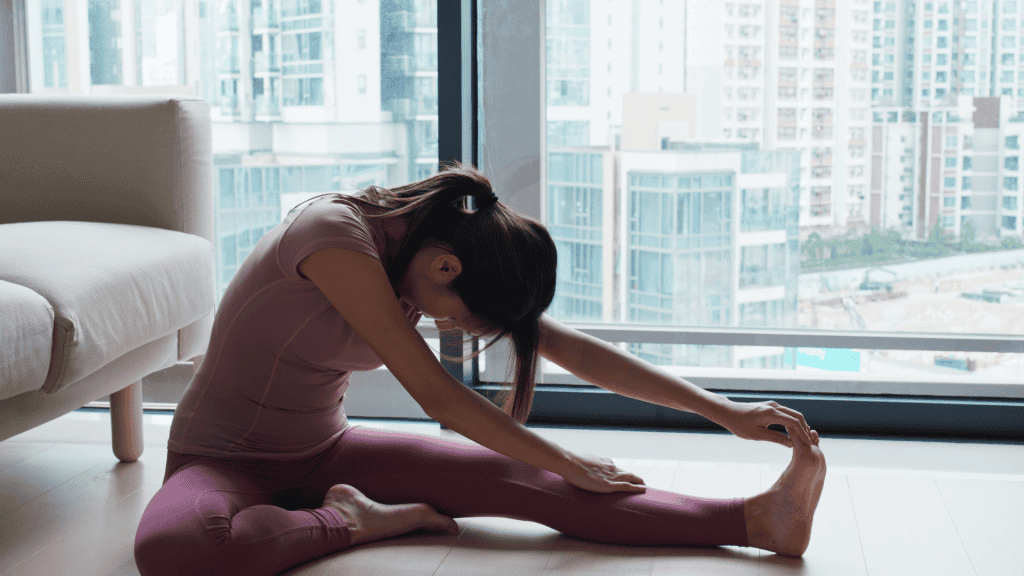
Moving too quickly or bouncing in a stretch can actually cause more harm than good. Instead, go slow. Ease into the stretch, stop when you feel resistance, and hold there. Staying still gives your muscles time to release.
That’s how real progress happens.
4. Progress comes from consistency, not pain
You don’t have to go deep or feel discomfort to improve. In fact, trying to stretch too far, too fast can make your body tense up.
Aim for a light stretch—a gentle pull is enough. Five minutes a day is more useful than one long session once in a while. What matters most is showing up often.
5. Track your progress with a photo
It’s easy to miss small improvements. Taking a quick photo can help you see the difference. Pick one stretch, like a forward fold, and snap a before picture. After two weeks of regular practice, take another.
You’ll likely notice more length, better posture, or less tension.
Bottom line is…
Be kind to your body. Flexibility isn’t about touching your toes on day one.
It’s about helping your muscles feel better, move better, and support you every day (yep, even when you’re sore from sitting).
7-Day Flexibility Habit Builder

Stretching works best when you do it regularly, not just once in a while. And you don’t need a perfect setup or tons of time. Just a few minutes a day can help your body feel looser, more comfortable, and ready to move.
This 7-day plan makes it easy to stay on track without overloading your schedule. It’s simple, flexible, and easy to repeat week after week.
Monday, Wednesday, and Friday: Full Flexibility Flow (5–10 minutes)
Start your week strong with the full routine from earlier. Take your time with each stretch and focus on your breath. If you’re busy, five minutes is enough to ease tension from sitting, sleeping weird, or moving less than usual.
Tuesday and Thursday: Pick 3 Tight Spots
Some days, your shoulders might feel tighter than your hips—or maybe your hamstrings are the issue. On these days, choose three areas that feel stiff and give each one 30 seconds to a minute.
That’s all it takes to keep things from locking up again.
Saturday: Optional Longer Stretch or Light Movement
If you have extra time or feel like your body needs a reset, stretch for a little longer. (10 to 15 minutes if you can)
Or mix in some light movement, like walking, dancing around your living room, or doing a few bodyweight exercises.
Anything that gets you moving counts.
Sunday: Rest or Easy Breathe + Stretch Combo
Give your body a break. If you want to move, try a few soft stretches like knees-to-chest or a gentle side-body reach. Pair it with some deep breathing for a calm, low-effort finish to your week.
Remember, you don’t have to touch your toes to make it count. Progress is showing up, even for a few minutes.
Your body will feel the difference—one stretch at a time.
You’re Not Stiff Forever — You Just Haven’t Started Stretching Yet
A lot of people think flexibility is only for dancers or folks doing fancy poses online. But honestly, that’s not what it’s about.
Flexibility just means moving your body with less tension and fewer aches. It helps you do everyday things like bending down, twisting, or walking without feeling stiff or sore.
Most of the time, you’re not “inflexible.” You’re just tight from sitting a lot, skipping stretches, or not knowing where to begin.
And that’s nothing to feel bad about.
Flexibility isn’t something you either have or don’t; it’s something YOU can build, step by step.
Even small changes make a difference. Maybe you wake up feeling a little looser, or getting out of your car feels smoother. That’s progress. You don’t have to go deep into every move or stretch for hours.
Just show up a little more often and move with a little more care.
So, save this guide, try the five-minute flow, or pass it to a friend who says they’re not flexible enough.
They’re not stuck—they just haven’t started stretching yet.
Start Building Flexibility Into Your Week
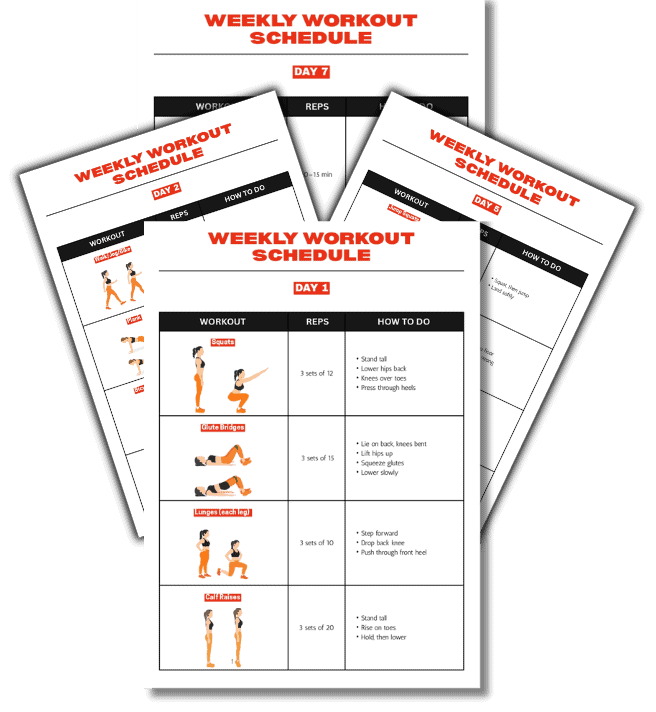
Doing a few stretches feels great, but long-term progress comes from making it a habit.
The Free Weekly Workout Schedule shows you how to organize your week so you’re not just stretching randomly, you’re building flexibility, strength, and balance in a clear, simple way.
It’s easy to follow and designed for busy schedules, so you can feel looser and more mobile without spending hours.
Frequently Ask Question
1. How long does it take to improve flexibility?
It depends on your starting point and how often you stretch, but most people feel some difference within 1–2 weeks especially if you’ve been stiff for a while. You may notice it’s easier to reach your toes, twist your torso, or sit with better posture. Long-term change takes consistency, not perfection. A little stretching a few days a week adds up fast.
2. Is stretching supposed to hurt?
Nope. Stretching should feel like a gentle pull, not pain, pinching, or burning. If it hurts, you’ve gone too far. Back off slightly until it feels like a mild, comfortable stretch. You should still be able to breathe deeply and stay relaxed. Think “ahh,” not “ow.”
3. What if I sit all day? Can this still help?
Yes, and honestly, that’s the best reason to start. Sitting for hours tightens your hips, hamstrings, and lower back. Daily stretches, especially ones that open up your spine and hip flexors can undo that stiffness and help you feel more mobile, even if your job keeps you in a chair most of the day.
4. Should I stretch before or after workouts?
Stretch after workouts when your body is warm. That’s when your muscles are more pliable, and you’ll get the most benefit. Before workouts, stick to light movement-based stretches (like arm swings or leg circles) to loosen up without overdoing it. Save the deeper holds for post-exercise or separate sessions.
5. I’m really stiff. Can I still start?
Absolutely. In fact, starting when you’re stiff is exactly when you need it most. You don’t need to be flexible to begin stretching, you just need to start where you are. Modify as needed, use support if it helps, and focus on steady improvement instead of reaching a certain pose. Your flexibility will improve with time and patience.










